There are various facts about British sign language that many people may not know. For starters, it is the fourth most used language in the UK!
[toc]
BSL is a visual-gestural language with its own grammar and syntax. Let us look at various other facts in detail!
British Sign Language Facts
BLS is the most common form of sign language used in the United Kingdom, and it has its own unique grammar and syntax.
It contains over 3000 signs, facial expressions, and body language to convey meaning.
BSL is a complex language that takes time to learn, but it is a fantastic tool for communication with those who are deaf or hearing impaired.
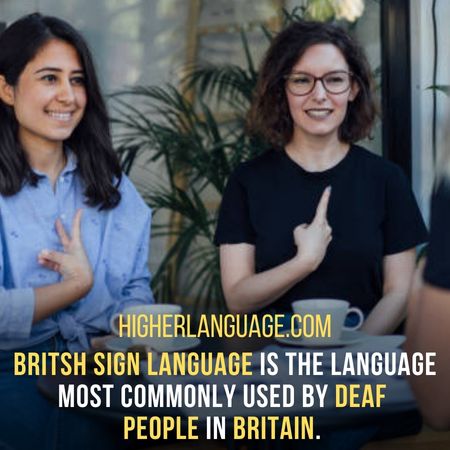
BSL is the language most commonly used by deaf people in Britain. It is closely related to other signing languages such as Irish Sign Language (ISL), French Sign Language (LSF), and Auslan.
It has a distinct grammatical structure that uses signs, facial expressions, and body language to communicate thoughts, feelings, and facts.
The history of BSL goes back hundreds of years, but it wasn’t until the 18th century that it was formally recognized as a language.
It has since grown in popularity, with more than 517,000 people using BSL as their main or preferred language in the UK today.
Many schools and universities offer courses in BSL, and there is even an organization dedicated to promoting its use – The British Deaf Association.
26 Facts About British Sign Language
Did you know that British Sign Language (BSL) is the first language of around 145,000 deaf people living in the UK?
It’s a visually transmitted language that communicates with hand shapes, facial expressions, and body movements.
There are many interesting facts about BSL, including its history, the number of signers, and its use today.
Here are some of the most interesting facts about British sign language.
1. BSL Has Its Roots In French Sign Language:
BSL developed from French Sign Language (LSF) in the early 19th century.
BSL vocabulary has expanded over the years and now includes signs from American Sign Language (ASL) as well.
It was then used by deaf communities throughout the UK, developing into a standardized language of its own over time.
2. There Are 5 Types Of BSL:
BSL has five main dialects: London, Scotland, Northern Ireland, Wales, and the Midlands.
Each region has its own distinct signs and regional accents that change how English words are signed.
It is important to learn all five dialects if you want to be a proficient BSL user.
3. BSL Is Its Own Unique Language:
Although similar to other sign languages, such as American Sign Language (ASL), BSL is a completely unique language with its own rules and grammar.
It also has different dialects depending on where it is spoken. For example, in England, there is London BSL, while Scotland has its own dialect of BSL.
Learning BSL can be a great way to communicate with others who are hearing impaired and understand the language.
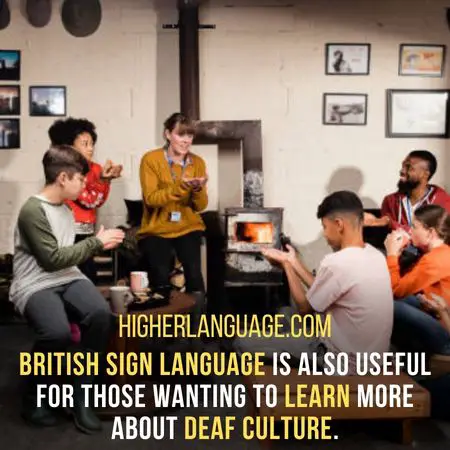
It is also useful for those wanting to learn more about Deaf culture or to make friends with people who use sign language as their main form of communication.
4. A Wide Range Of People Use It:
BSL is more than just a language used by deaf people; other groups also use it.
Such as hard-of-hearing individuals, family members of deaf people, and those who are simply learning it as a second language.
Plus, some teachers and trainers help deaf children learn BSL in special institutes.
5. It Is The Fourth Most Used Language In Britain:
British Sign Language (BSL) is Britain’s fourth most used language, behind English, Welsh, and Polish.
This means that BSL significantly impacts British culture and everyday life. There are currently over 87,000 people who use BSL as their primary language in the UK.
6. It Has Its Own Grammar:
BSL has its own grammar, including rules on how words should be signed and sentences should be structured.
BSL also has a system of classifiers that represent nouns’ shape, size, and other properties.
This makes it easier to describe something in more detail than would be possible using English alone.
The language also uses space to convey meaning – for example, signing further away from the body can indicate distance or degree.
This means it is very different from spoken languages in terms of syntax and structure.
7. It Has An Established Literature:
BSL has its own literature, including books, films, and television programs that are made specifically for sign language users.
It also has its own grammar and syntax, which are very different from spoken languages.
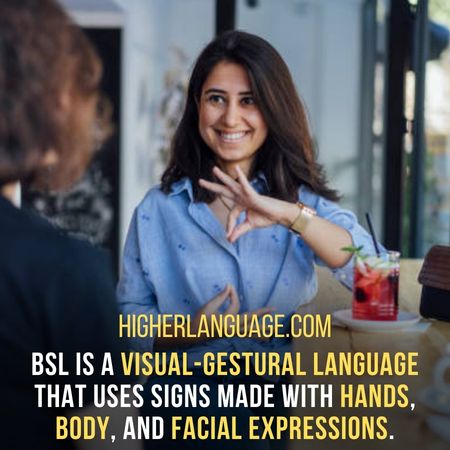
BSL is a visual-gestural language that uses signs made with the hands and body, facial expressions, and other nonverbal communication cues.
This means a wealth of material is available to learn from, whether you are a beginner or more experienced in the language.
8. It Is A Living Language:
BSL is not a static language. Like any other living language, it evolves over time and is constantly changing.
It has been influenced by many other languages and cultures, including English, American Sign Language (ASL), and French Sign Language (LSF).
This means that it is important to stay up-to-date with the latest trends to keep up with the changes.
9. It Is Used Across The UK:
Many people use BSL throughout the United Kingdom, including England, Scotland, Wales, and Northern Ireland.
It is the most widely-used sign language in Europe and has been recognized as the official language of the UK since 2003.
There are also several regional dialects within the language, meaning different signs are used in different parts of the country.
10. The British Government Recognizes It:
British Sign Language is officially recognized as a language by the British government and protected under the Equality Act 2010.
This means that organizations must provide reasonable adjustments for people who use BSL, such as providing sign language interpreters when necessary.
11. It Is An Independent Language:
BSL is not a form of English but an independent language.
This means that the structure and grammar differ from spoken languages, with simple sentences comprising whole signs rather than individual words.
The language also has its own set of signs unique to British sign language.
So even if you know a little bit of English sign language, it won’t be enough to fully understand what is being said in British Sign Language.
12. More Than 87,000 People Speak It:
British Sign Language is used by more than 87,000 people in the UK, with more than 87,000 of those being deaf.
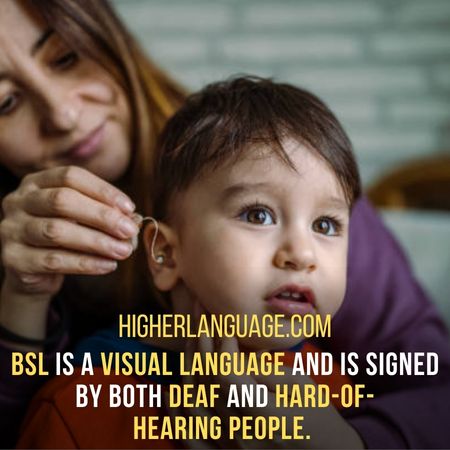
BSL is a visual language and is signed by both deaf and hard-of-hearing people.
That makes it one of the largest minority languages in Britain today.
13. It Is A Recognised Language In British Education:
British Sign Language has official recognition as a qualification in the UK.
It is recognized by universities and colleges as a language, meaning it can be studied at these institutions.
This recognition also allows deaf people to access education more easily than they would without this qualification.
14. It Is Not Just For The Deaf Community:
The deaf and hard-of-hearing community mostly uses Whilst British Sign Language, but it is not just for them.
Hearing people can also learn and use the language to communicate with deaf people.
British Sign Language has a range of dialects and variations depending on the region in which it is used.
So even if you are already familiar with sign language from another country, you may need to adjust your signs accordingly.
15. It Is A Growing Language:
The number of people communicating in British Sign Language is increasing, and so is its recognition as a language.
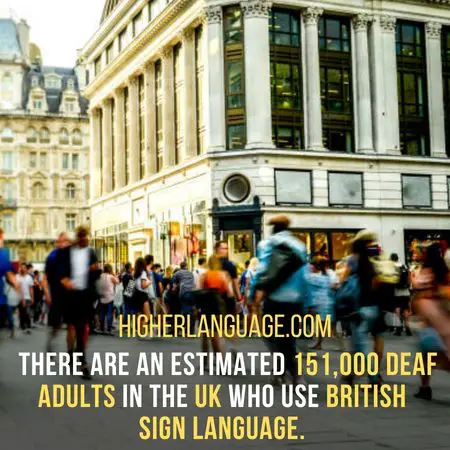
According to the British Deaf Association, there are an estimated 151,000 deaf adults in the UK who use BSL as their main form of communication.
It is also estimated that around 70,000 children in the UK use it as their first language.
16. It Has Its Own Grammar Structure:
Unlike spoken languages, BSL follows a topic-comment grammar structure – abbreviated to TC.
This means that the main point of the conversation is communicated first, followed by additional facts about it.
In contrast, English typically follows an SVO (Subject-Verb-Object) syntax.
17. It Uses Visual Cues and Gestures:
BSL is considered a visual or gestural language, meaning that it uses movements of the hands, arms, and face and body positioning to communicate.
These gestures often represent words in the English dictionary, but they can also have their own meanings.
18. It Has Its Own Culture:
The Deaf Community has its unique culture and language, expressed through BSL.
Being part of the community involves understanding key terms and displaying certain behaviors that are specific to the Deaf world.
This includes using handshakes as a form of greeting, avoiding eye contact, and using the proper sign language etiquette.
19. It’s Used All Over The UK:
BSL is used all over the United Kingdom, not just in England. It is a vibrant language that has its own dialect, depending on which area of Britain you are in.
It also has many different accents and inflections. This makes it a unique and exciting language to learn.
20. Rich History:
British Sign Language has an interesting history that dates back centuries.
BSL was believed to be first used in the 17th century when people with hearing impairments communicated through signed hand gestures and facial expressions.
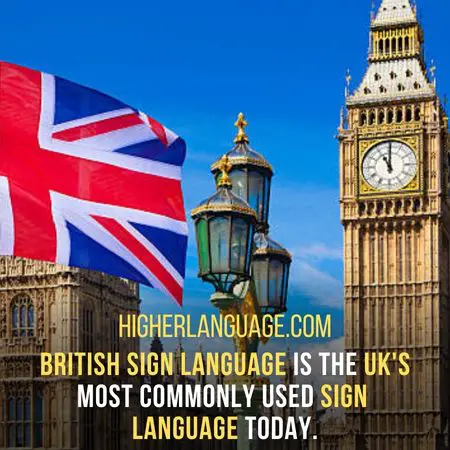
British Sign Language is the UK’s most commonly used sign language today.
21. Official Recognition:
The government officially recognized British Sign Language in 2003, and since then, it has been taught as a foreign language in some schools.
It is now considered an official language in its own right, with thousands of people using it daily for communication.
22. Benefits Of Sign Language:
Learning sign language can be incredibly beneficial for those who are either deaf or hard of hearing.
It allows them to communicate with others more easily, and it is also a great way to learn new skills.
Sign language is also beneficial for those who want to learn how to communicate clearly and express themselves better in an alternative manner.
23. Origin Of BSL:
It was developed in the 18th century by deaf people living in Britain, who used it to communicate with each other.
BSL was officially recognized as a language in 2003, making it the first sign language to be legally recognized by the British government.
It is the preferred language of the British Deaf community and has a rich history and culture.
24. How It’s Used Today:
BSL is still used widely today by people who are deaf or hard of hearing and those who teach sign language.
It is also gaining popularity on social media platforms such as Twitter and YouTube as more people discover the power of signing.
25. Main Features:
BSL differs from other sign languages because it uses two hands to form its signs rather than one hand for each letter.
This can make it difficult for those who are learning BSL, but it also makes it a unique language in its own right.
Signs are composed of movements, facial expressions, and hand shapes that portray meaning.
26. History:
BSL has existed since the 18th century and was originally called “The Manchester System”.
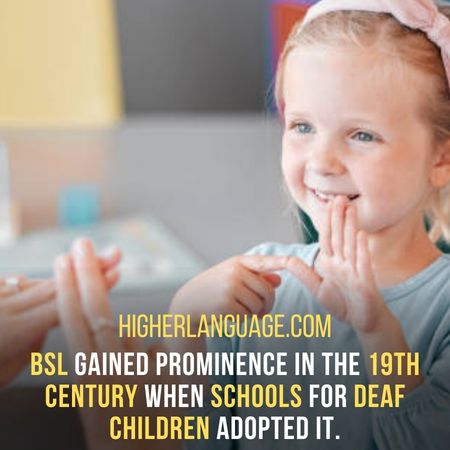
It gained prominence in the 19th century when schools for deaf children adopted it as a way to communicate with each other.
BSL has since been used for generations by British deaf people and is now being taught in schools nationwide.
Final Thoughts:
There are many interesting facts about British sign language. British Sign Language is an incredibly important language that helps bridge communication gaps between those who use BSL and those who do not.
It is a beautiful, expressive language with rich rules, movement, and direction. It’s also Britain’s fourth most used language, making it even more important for people to understand and appreciate its value.
With facts like these, it’s no wonder BSL has become an integral part of British culture.